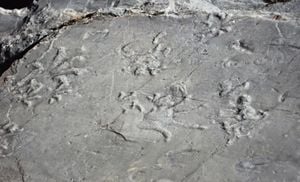Rare sightings of the elusive oarfish, often dubbed the "doomsday fish," have sparked both excitement and intrigue following one such incident off Southern California's La Jolla Shores.
The discovery of the fish floating near the shore over the weekend marks just the 20th recorded oarfish to wash up on California's coast since 1901, making it an event worth noting.
A group of science enthusiasts—kayakers and snorkelers—stumbled upon the dead oarfish during their excursion, according to reports from the Scripps Institution of Oceanography at UC San Diego.
With the collaborative effort of locals to safely transport the creature from the water to shore, the oarfish was later taken to the marine facility for analysis.
Brittany Hook, assistant director of communications at Scripps, shared, "Thanks to the work from these locals, scientists will be able to study this mysterious species as it will become part of the Marine Vertebrate Collection at Scripps, one of the largest collections of deep-sea fish globally."
The oarfish, measuring between 10 to 12 feet long, is known for its impressive size; these fish can sometimes grow as long as 30 feet.
A necropsy is scheduled to be performed by scientists from NOAA Southwest Fisheries Science Center and Scripps to determine the cause of the fish's death, which remains undetermined at this time.
Interestingly, the oarfish's reputation extends beyond its size; it has long been associated with various myths, particularly within Japanese folklore.
Traditionally seen as omens of natural disasters, oarfish are popularly thought to appear before events like earthquakes or tsunamis, though scientific verification of this belief is lacking.
This sighting has ignited discussions about the oarfish's historical ties to seismic activity, especially as just days after its discovery, California experienced a 4.4-magnitude earthquake.
According to Hook, "While there has been speculation connecting oarfish sightings to seismic events, this correlation has not been proven. Reports of oarfish washing up before earthquakes have existed, yet no direct scientific links have been established."
Despite the folklore and sensational headlines, ichthyologists advise caution against hastily connecting oarfish appearances with impending disasters.
Historically, oarfish appearances have coincided with seismic events, but experts like Hiroyuki Motomura, ichthyology professor at Kagoshima University, indicate such claims lack empirical evidence.
He explained, "I believe these fish tend to rise to the surface when their physical condition is poor, leading them to be easily discovered when dead."
Oarfish typically reside deep beneath the ocean surface, often between 700 and 3,280 feet down, which lends to its rarity and mystique when it ventures near coastal shores.
Since this species is seldom seen, each find offers valuable opportunities for scientific insight, especially around their biology and behavior.
Following the necropsy, the remains of the oarfish will be preserved as part of Scripps' Marine Vertebrate Collection, which contributes to the larger body of knowledge about marine life.
Researchers are particularly eager to study oarfish as they also possess fascinating physiological traits, including their elongated bodies and unique swimming capabilities.
While the collective fascination surrounding this discovery continues, local scientists feel encouraged about the potential findings linked to health, nutrition, and environmental conditions of marine species.
They eagerly await the results of the investigations to deepen their understandings of this enigmatic creature.
The appearance of the oarfish has spurred curiosity and reminded people of nature's mysteries and the often-blurred lines between myth and science.
Each sighting resonates with people not only for the fish's physical presence but for the broader intrigue surrounding its history and lore.
This incident serves as yet another captivating chapter surrounding the oarfish, heightening interest within the scientific community and the general public alike.



